JEE Exam > JEE Notes > Mock Tests for JEE Main and Advanced 2025 > Revision Notes - Trigonometric Functions
Trigonometric Functions Class 11 Notes Maths Chapter 3
- The trigonometric ratios are the ratios between the two sides of a right-angles triangle with respect to an angle and hence they are real numbers.
- The angle θ taken into consideration may be acute, obtuse or right angle.
- Various trigonometry formulas related to the basic trigonometric ratios which must be remembered include:
1) sin2 θ + cos2 θ = 1
2) sec2 θ -tan2 θ = 1
3) cosec2 θ - cot2 θ = 1
4) sin θ cosec θ = tan θ cot θ = sec θ cos θ = 1
5) sin2 θ + cos2 θ = 1, so each of them is numerically less than 1.
6) |sin θ| ≤ 1 and |cos θ| ≤ 1
7) -1 <cosec θ<1 and -1 <sec θ<1
8) tan θ and cot θ may take any value. - The trigonometry ratios can be either positive or negative depending on the quadrant in which they lie. The figure given below illustrates the various trigonometric ratios and their signs in various quadrants:

- Range of f: X →Y is the set of all images f(x) which belongs to Y, i.e.
Range f = {f(x) ∈ Y: x ∈ X} ⊆ Y.
The domain and range of various trigonometry ratios are given below:Trigonometric FunctionDomainRangesin xR-1 ≤ sin x ≤1cos xR-1 ≤ cos x ≤1tan xR – {(2n + 1)π/2, n ∈ I}Rcosec xR – {nπ, n ∈ I}R – {x: -1 < x <1}sec xR – {(2n + 1)π/2, n ∈ I}R – {x: -1 < x <1}cot xR – {nπ, n ∈ I}R - Given below is the trigonometry table of the basic ratios for some frequently used angles. These formulas must be memorized as they are used in almost all questions:Angle (x)sin xcos xtan xcosec xsec xcot x0°010undefined1undefined90° = π/210undefined1undefined0180° = π0-10undefined-1undefined270° =3π/2-10undefined-1undefined0360° = 2π010undefined1undefined
- Some other formulas of trigonometry which are useful in solving questions:Angles0°30°45°60°90°sin01/21/√2√3/21cos1√3/21/√21/20tan0√3/21√3undefinedcosecundefined2√22/√31sec12/√3√22undefinedcotundefined√311/√30
- The values of various trigonometric ratios vary in different quadrants. The variation is listed below quadrant wise:1. sine- increases from 0 to 1First Quadrant
2. cosine- decreases from 1 to 0
3. tangent- increases from 0 to ∞
4. cotangent- decreases from ∞ to 0
5. secant- increases from 1 to ∞
6. cosecant- decreases from ∞ to 11. sine- decreases from 1 to 0Second Quadrant
2. cosine- decreases from 0 to -1
3. tangent- increases from -∞ to 0
4. cotangent- decreases from 0 to -∞
5. secant- increases from -∞ to -1
6. cosecant- increases from 1 to ∞1. sine- decreases from 0 to -1Third Quadrant
2. cosine- increases from -1 to 0
3. tangent- increases from 0 to ∞
4. cotangent- decreases from ∞ to 0
5. secant- decreases from -1 to -∞
6. cosecant- increases from -∞ to -11. sine- increases from -1 to 0Fourth Quadrant
2. cosine- increases from 0 to 1
3. tangent- increases from -∞ to 0
4. cotangent- decreases from 0 to -∞
5. secant- decreases from ∞ to 1
6. cosecant- decreases from -1 to ∞- Sin and cos both have 2π as their period.
- tan function has π as the period.
- The reciprocal functions have the same period as that of the original functions.
- If the period of f(x) is T then that of kf(ax+b) is T/mod (a), hence period is affected by coefficient of x only.
- If f(x) has its period T and g(x) has its period M, then (af(x) + bg(x)) has its period < L.C.M. (T, M). Moreover if f(x) and g(x) are basic trigonometric functions then period of [af (x) + bg(x)] = L.C.M. (T, M).
- If a constant is added, subtracted, multiplied or divided in a periodic function, its period is unaffected.
- Graphs of some basic trigonometric functions:
1) sin x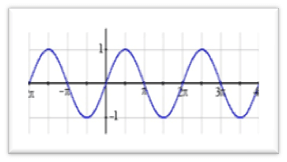 2) cos x
2) cos x 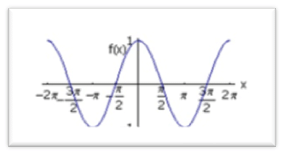 3) tan x
3) tan x 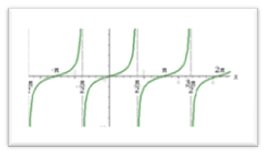 4) cot x
4) cot x 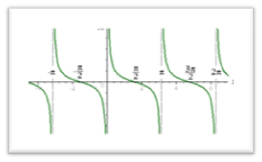 5) sec x
5) sec x 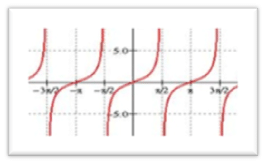
The document Trigonometric Functions Class 11 Notes Maths Chapter 3 is a part of the JEE Course Mock Tests for JEE Main and Advanced 2025.
All you need of JEE at this link: JEE
|
357 docs|100 tests
|
FAQs on Trigonometric Functions Class 11 Notes Maths Chapter 3
| 1. What are the basic trigonometric functions? |  |
| 2. How are the trigonometric functions defined on the unit circle? |  |
Ans. On the unit circle, the trigonometric functions are defined as follows: the sine of an angle is the y-coordinate of the point on the unit circle corresponding to that angle, the cosine of an angle is the x-coordinate, and the tangent of an angle is the ratio of the sine to the cosine.
| 3. What is the range of the sine and cosine functions? |  |
Ans. The range of the sine and cosine functions is [-1, 1]. This means that the values of these functions can never exceed 1 or be less than -1.
| 4. How are the reciprocal trigonometric functions defined? |  |
Ans. The reciprocal trigonometric functions are the cosecant (csc), secant (sec), and cotangent (cot). They are defined as the reciprocals of the sine, cosine, and tangent functions, respectively. For example, the cosecant of an angle is equal to 1 divided by the sine of that angle.
| 5. What are the periodicity and symmetry properties of the trigonometric functions? |  |
Ans. The sine and cosine functions are periodic with a period of 2π. This means that their values repeat every 2π radians or 360 degrees. The tangent function is also periodic, but with a period of π. The sine function is an odd function, which means that sin(-x) = -sin(x), while the cosine function is an even function, which means that cos(-x) = cos(x).
Related Searches















